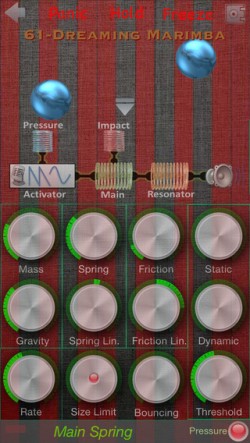 Anckorage Spring has introduced SpringSound, a new physical-modeling synthesizer for iOS.
Anckorage Spring has introduced SpringSound, a new physical-modeling synthesizer for iOS.
SpringSound produces sounds by simulating interactions and vibrations of a set of activators, and masses connected to springs. The model offers detailed control of an array of features including:
- gravity
- bouncing
- fluid and static friction,
- mechanical limits,
- non-linear functions, and more.
It can be used as a sound generator or as an effect, using its Audio-In feature, letting it be used as a physical-modeling effects processor.
Here’s a video demo of SpringSound:
Features:
- Powerful and fully editable, physical modeling synthesis engine
- Large set of presets
- An alternative to common subtractive analog synthesis techniques,
- Detailed edit and real-time MIDI control of real-world parameters like Mass, Force, Gravity, etc.
- Can be used as a sound generator or as an effect processor (audio in available),
- Create a wide range of rich sounds from realistic to other-worldly, from simple to ‘dangerous’,
- 88,200 Hz internal sampling rate,
- Also works as an IOS Haken Continum Remote (only on the iPad version),
- Core MIDI compliant (including virtual and network MIDI),
- Playable by any MIDI device,
- Playable via touchscreen with innovative physical controls,
- Fully Audiobus 2 compliant including state saving, and based on The Amazing Audio Engine (by Michael Tyson)
- Inter-app audio compliant,
- Available on iPad and iPhone, with portrait and landscape mode supported, IOS 7 and 8.
Developer Christophe Duquesne notes that SpringSound is the big brother of his earlier app Anckorage-Spring, with a reworked physical model, and additional features and presets.
SpringSound is available now for US $2.99 in the App Store.
If you’ve used SpringSound, leave a comment and let us know what you think of it!

I can count the number of physical modeling synths for iOS on one hand, and still have a few fingers left. I’ve been enjoying playing with this. It is capable of a whole range of sounds that aren’t achievable in the subtractive or wavetable world.
The on-screen playing interface provides per-note pitch control (X axis) and volume control (Y axis).
Previewing presets is a little quicker in the editor (bottom drawer). There’s a scrolling list that loads immediately. Using the library requires an extra step.
I’d like to see an added “i” (for info) button for each entry in the library, so that when you tap “i” it will work as it currently does, if you just tap elsewhere in the list it immediately loads the preset. Would also like to see ways to organize the library with folders.
I’d also like to see the ability to load samples as activators (so a chiff or bow stroke could be used as an attack).
Thanks
That’s nice to have input from users for new features. I’m currently working on a small update, I will try to take them into account (may be later for samples, since it is a bigger feature… with an additional work to start with a nice sample set).
Christophe Duquesne
Ill pass, it might have some unique tricks but a lot more care should have been put into the UI design.
These days sounds, functionality AND design determine wether an app gets due attention.
If it looks scruffy I won’t even watch the demo video
Sorry to say
Looks and sounds fantastic!
Great work Christophe!!